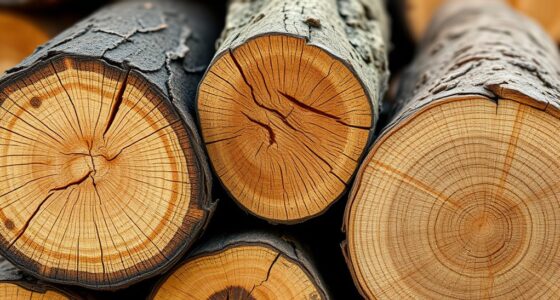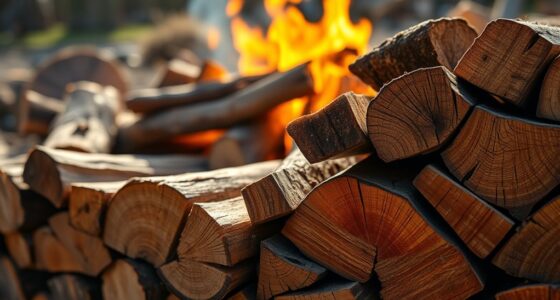To gather firewood sustainably, focus on collecting dead, fallen, or diseased wood that won’t harm living trees or understory plants. Use proper tools and techniques to make clean cuts, avoiding damage to young trees or sensitive habitats. Follow local regulations and obtain necessary permits to make sure responsible harvesting. Limit your collection to small areas and respect wildlife zones. By doing so, you help preserve the forest’s health—learn more ways to do this effectively as you continue.
Key Takeaways
- Prioritize collecting dead, fallen, or diseased wood to minimize impact on living trees and forest regeneration.
- Use proper tools and techniques to ensure clean cuts, reducing environmental disturbance and promoting tree health.
- Follow local regulations and obtain necessary permits, respecting seasonal and zone-specific restrictions.
- Avoid harvesting near wildlife nesting sites and during breeding seasons to protect habitats and biodiversity.
- Limit collection to small, dispersed patches and maintain buffer zones to support ecosystem stability and resilience.
Understanding Forest Ecosystems and the Importance of Sustainability
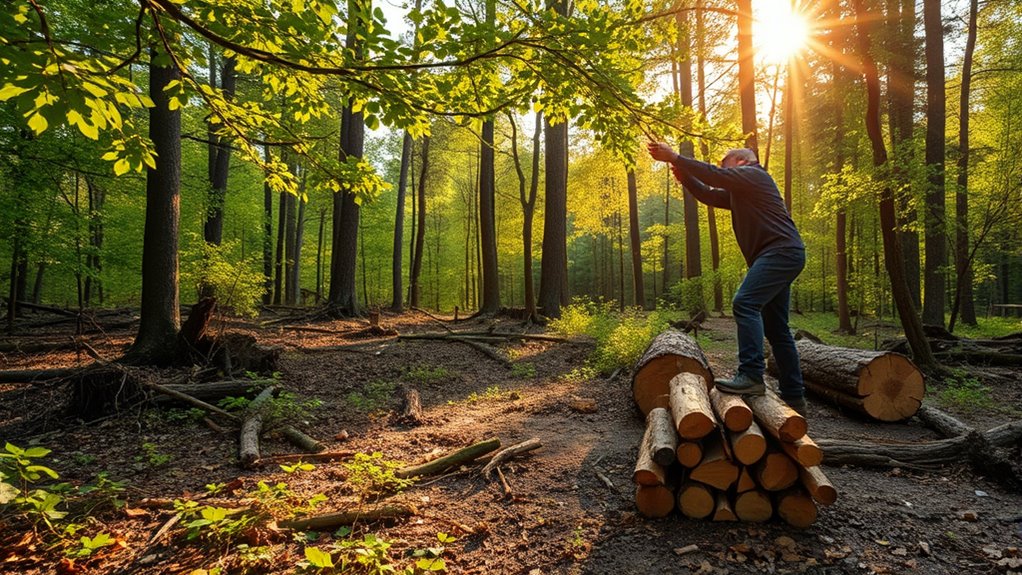
Understanding forest ecosystems is essential because these environments provide the foundation for sustainable firewood harvesting. When you grasp how forests maintain forest health and ecological balance, you can make better decisions that protect these crucial systems. Forests aren’t just sources of wood; they’re complex communities where plants, animals, fungi, and microorganisms interact. Overharvesting can disrupt this delicate balance, leading to erosion, loss of biodiversity, and weakened resilience. By respecting ecological principles, you help ensure future generations can benefit from healthy forests. Recognizing the interconnectedness of forest components can lead to more sustainable practices that maintain ecosystem health and productivity. Additionally, understanding forest regeneration processes is vital for ensuring that harvesting methods support natural growth cycles and prevent depletion of resources. This knowledge emphasizes the importance of adaptive management strategies that respond to changing forest conditions over time.
Identifying Dead, Fallen, and Diseased Wood for Harvesting
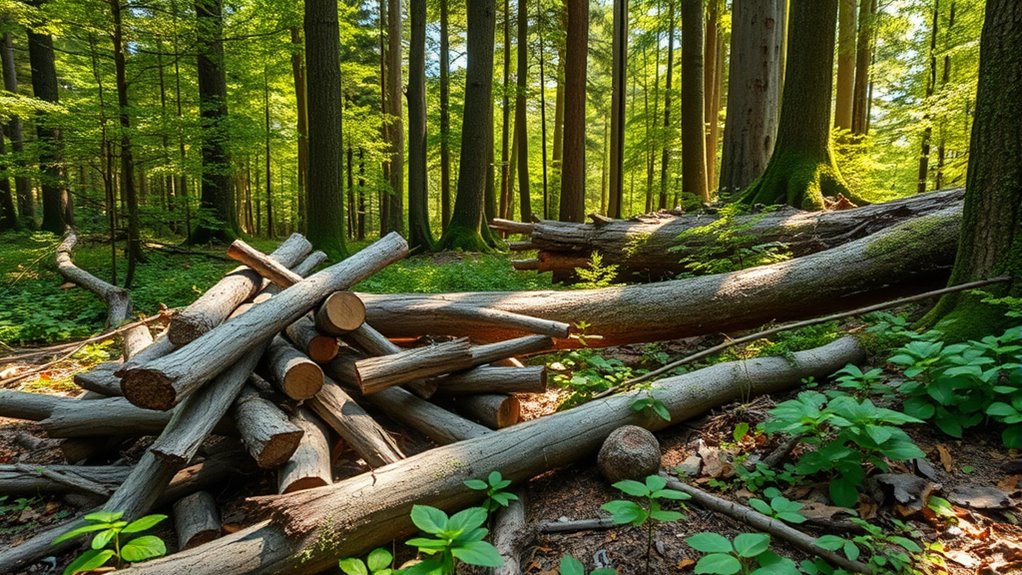
To harvest firewood sustainably, you need to accurately identify dead, fallen, and diseased wood, as these sources are often more suitable and less disruptive than cutting live trees. Start by observing the condition of the wood: deadwood usually shows signs of decay, such as soft spots, holes, or a crumbly texture. Fallen wood is easily spotted on the forest floor, often broken or weathered, making it ideal for harvesting without harming living trees. When spotting diseased trees, look for discoloration, unusual growths, or fungal growths on the bark or wood. Diseased wood can pose a risk of spreading pathogens; thus, only harvest if it’s fallen or clearly dead. Proper identification ensures you’re gathering wood responsibly without damaging the forest’s health. Additionally, understanding the subtopic 2: What Defines A Tiny House can help you appreciate sustainable living principles that can be applied to responsible resource use. Incorporating knowledge of forest ecology and the importance of ecosystem health can further guide sustainable harvesting practices. Recognizing the market demand for sustainable wood can also encourage responsible sourcing and conservation efforts.
Choosing the Right Tools and Techniques for Careful Cutting

Choosing the right tools and techniques is essential for making careful cuts that minimize damage to the surrounding environment. Using a sharp, well-maintained chainsaw ensures cleaner cuts and reduces strain, supporting chain saw safety. Proper chopping techniques, like starting cuts on the correct side and avoiding excessive force, help prevent accidents and tree damage. Select tools suited for the wood type and size to avoid unnecessary stress on the tree. Here’s a quick guide:
| Tool | Proper Technique | Safety Tip |
|---|---|---|
| Chainsaw | Use steady, controlled motions; avoid rushing | Wear protective gear |
| Axe or Maul | Make clean, deliberate swings; avoid twisting | Check for stability beforehand |
| Hand Saw | Use smooth, consistent strokes | Keep fingers clear |
| Wedges | Insert at the right angle to guide falls | Keep hands clear of blades |
Respecting Local Regulations and Permits for Firewood Collection
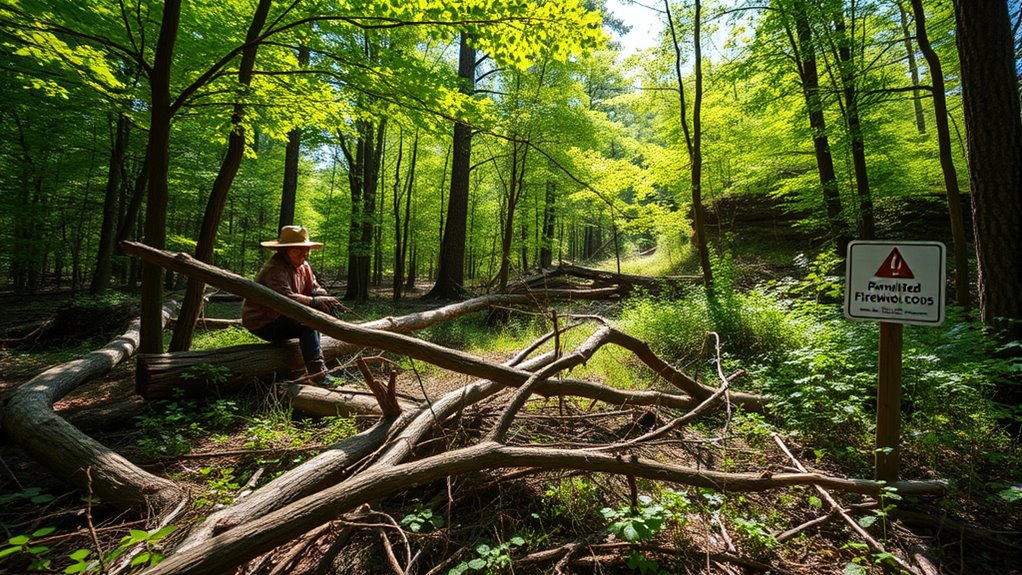
Before collecting firewood, you need to understand local regulations and permit requirements. Failing to follow these rules can lead to fines or damage to your reputation. Make sure to check with local authorities to stay compliant and harvest responsibly. Additionally, being aware of sustainable harvesting practices helps ensure that wood collection does not harm the health of the forest ecosystem. Incorporating energetic alignment principles can also promote a more mindful and respectful approach to gathering resources from nature. Recognizing the importance of community engagement can foster better relationships with local stakeholders and promote conservation efforts. Understanding the importance of color accuracy in projectors can lead to more satisfying visual experiences when setting up your home theater.
Permit Requirements Overview
Understanding local regulations and permit requirements is essential for responsible firewood harvesting. Before collecting firewood, check if permits are needed, as rules vary by area. Some regulations specify:
- The type of wood allowed for collection
- Limits on the amount you can gather
- Designated collection zones
- Seasonal timing restrictions to prevent overharvesting
Obtaining permits ensures your firewood storage remains compliant and sustainable. Pay attention to seasonal timing, as harvesting outside permitted periods can harm the forest’s regeneration. Keep records of your permits and follow all guidelines to avoid fines or damaging the environment. Knowing and respecting these regulations helps preserve forest health and provides a reliable firewood source over time. Always verify local rules before heading out to collect wood, and plan your activity accordingly. Additionally, being aware of Fokos policies can help you stay informed about regional guidelines and best practices. Properly understanding firewood regulations can help you avoid unintentional violations and contribute to forest conservation efforts.
Local Regulations Compliance
Respecting local regulations and permits is essential for legal and sustainable firewood collection. Before gathering firewood, check for specific rules about firewood storage and seasonal harvesting restrictions in your area. Some regions limit the amount you can collect or require permits to prevent overharvesting. Failing to follow these regulations can harm local ecosystems and lead to fines. Make sure you understand the rules about where and when you can collect wood, especially during peak seasons. Properly storing firewood also matters; some areas have guidelines to prevent forest damage or pest spread. Additionally, being aware of best anime movies can provide you with relaxing entertainment after a day of responsible firewood gathering. Engaging in community engagement during your downtime can also foster problem-solving skills that might help you navigate complex regulations more effectively. Staying informed about regulatory updates is also crucial, as rules may change unexpectedly, affecting your collection plans. By complying with local laws, you help maintain healthy forests, ensure your activities are sustainable, and avoid legal issues. It’s also helpful to stay informed about any changing regulations that may affect firewood collection in your region. Always verify current regulations before heading out to gather your firewood.
Selecting Harvesting Sites to Minimize Environmental Impact
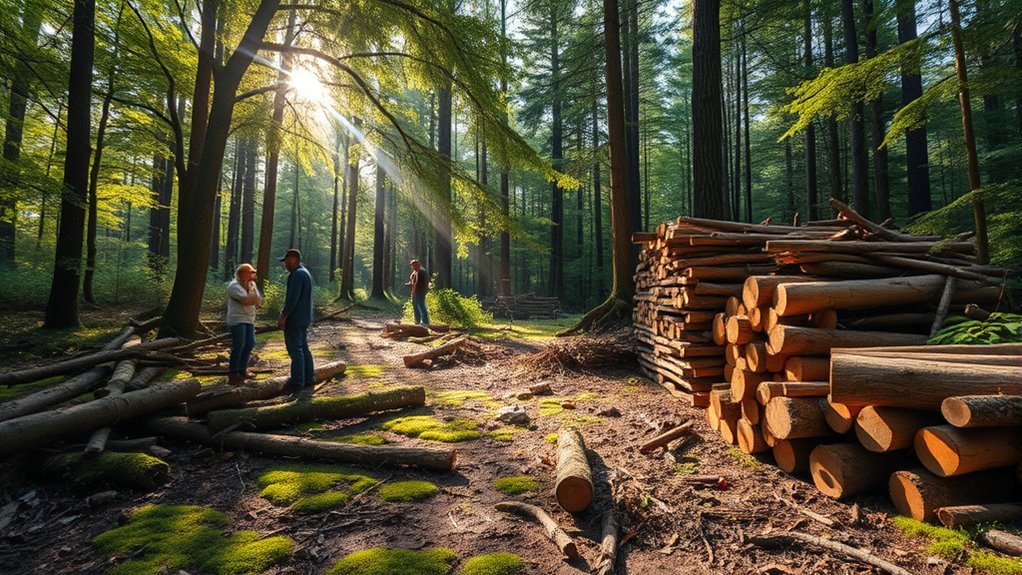
Choosing the right harvesting sites is essential to reducing environmental impact. When selecting sites, focus on minimizing disturbance to the surrounding ecosystem. To do this effectively, consider these key points:
- Pick areas with abundant dead or fallen wood rather than cutting live trees. This practice supports forest health by allowing natural decomposition and habitat preservation.
- Avoid sites near water sources to prevent erosion and water pollution.
- Steer clear of fragile habitats or wildlife nesting zones.
- Limit your harvest to small, dispersed patches instead of large, concentrated areas.
- Be mindful of ecosystem dynamics to ensure sustainable harvesting practices and the long-term vitality of the ecosystem. Additionally, understanding the horsepower of electric dirt bikes can help you appreciate how sustainable energy sources support eco-friendly outdoor activities like responsible firewood gathering. Proper planning and awareness of sustainable energy sources can further enhance sustainable harvesting efforts. Recognizing the importance of remote work productivity can also inspire new methods for planning and managing sustainable practices efficiently.
Practicing Responsible Cutting to Promote Forest Regeneration
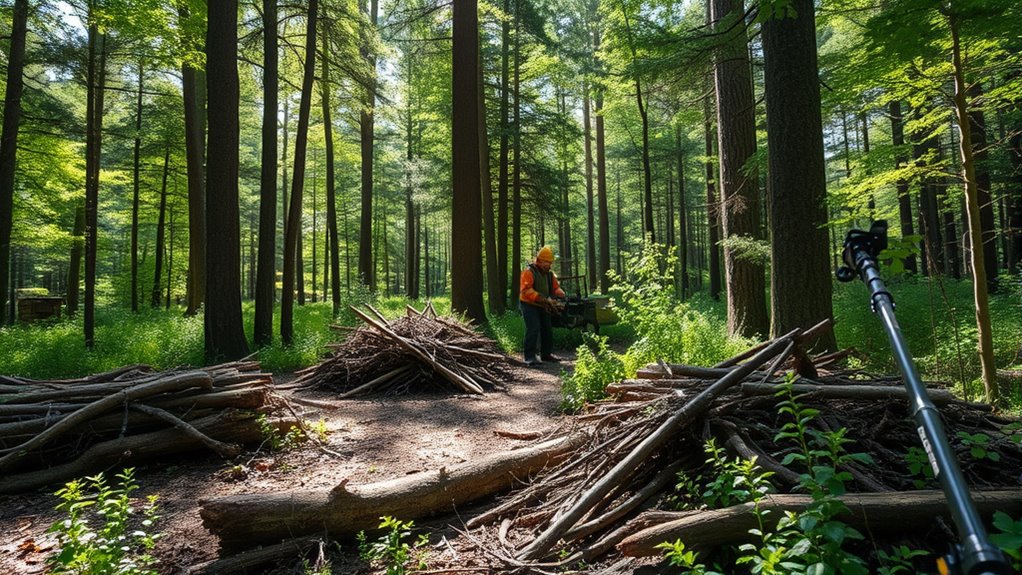
Practicing responsible cutting guarantees that firewood harvesting supports forest health and encourages natural regeneration. You should focus on selective tree pruning to remove weak or diseased branches, promoting healthy growth. When creating firebreaks, make certain you cut in a way that minimizes soil disturbance and protects young seedlings. Properly spaced cuts allow for better airflow and sunlight, fostering new growth. Use the table below to guide your practices:
| Technique | Purpose |
|---|---|
| Tree pruning | Enhances tree health and regeneration |
| Firebreak creation | Prevents wildfires while protecting young saplings |
| Selective harvesting | Maintains forest diversity and stability |
Additionally, understanding the forest ecosystem can help you make more sustainable decisions during harvesting. Recognizing the importance of soil preservation ensures that the forest remains resilient and capable of supporting diverse plant life.
Managing Your Firewood Supply Efficiently and Ethically
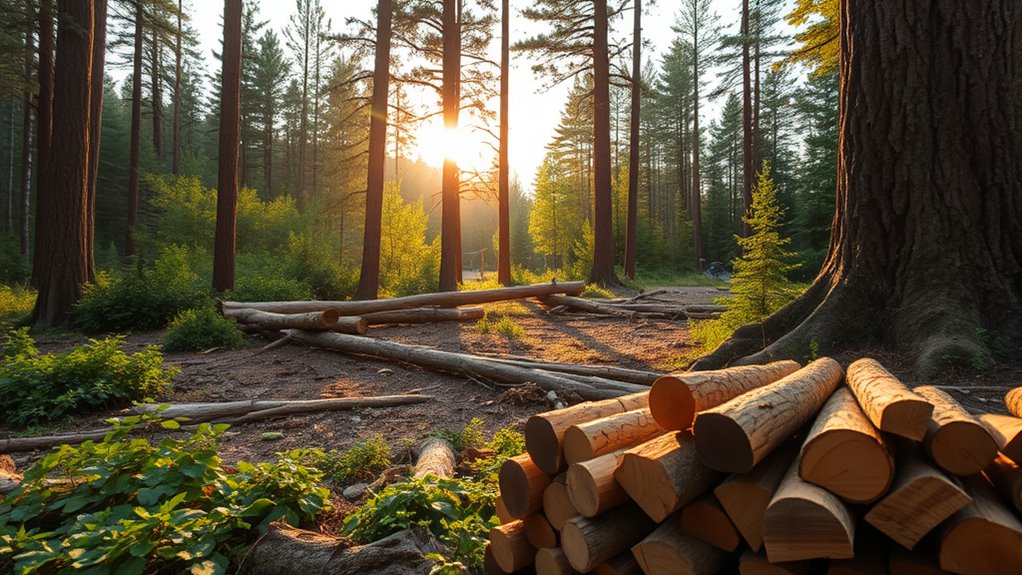
Have you ever considered how managing your firewood supply efficiently and ethically can benefit both your household and the environment? Proper firewood storage ensures your wood stays dry and ready, improving heating efficiency. To do this effectively, consider these points:
Proper firewood storage benefits your home and the environment through efficient, ethical practices.
- Store firewood off the ground to prevent moisture absorption.
- Keep it covered but well-ventilated to promote drying.
- Split logs into smaller pieces to accelerate seasoning.
- Regularly check for signs of pests or mold.
- Incorporate space and organization strategies to create designated zones for your firewood, making it easier to access and maintain.
Protecting Young Trees and Understory Vegetation During Harvesting
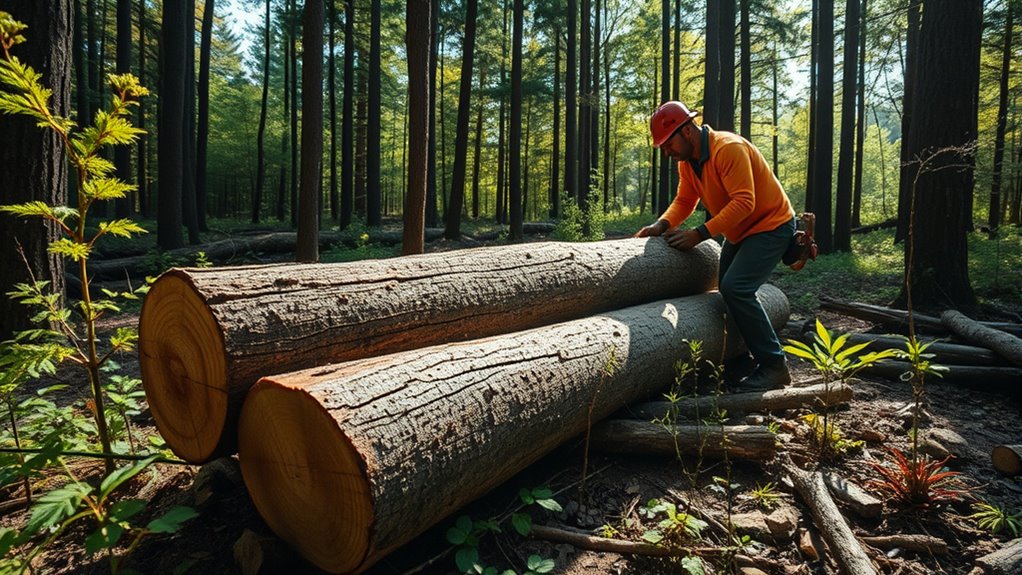
Proper firewood harvesting not only guarantees a sustainable supply but also safeguards the surrounding ecosystem. To do this, focus on seedling protection by avoiding damage to young trees during collection. Keep your tools and movements controlled to prevent trampling or uprooting seedlings, which are essential for forest regeneration. Preserving understory vegetation is equally important; don’t clear or disturb the shrubs and small plants that support biodiversity and soil health. Stick to designated harvesting areas and avoid heavy machinery near delicate seedlings and understory plants. By being mindful of your impact and taking care to protect these young and crucial parts of the forest, you help maintain a healthy ecosystem that continues to provide firewood sustainably for years to come.
Safeguarding Wildlife Habitats While Collecting Firewood

To effectively safeguard wildlife habitats while collecting firewood, you need to be mindful of the animals and their homes. Avoid disrupting wildlife corridors and nesting sites by following these tips:
- Identify and steer clear of areas marked as wildlife corridors, ensuring animals can move freely.
- Avoid collecting wood near known nesting sites during breeding seasons.
- Limit your harvesting to fallen or dead wood, reducing disturbance to living habitats.
- Maintain a buffer zone around sensitive areas, preserving habitat connectivity.
Promoting Community Awareness and Support for Sustainable Practices
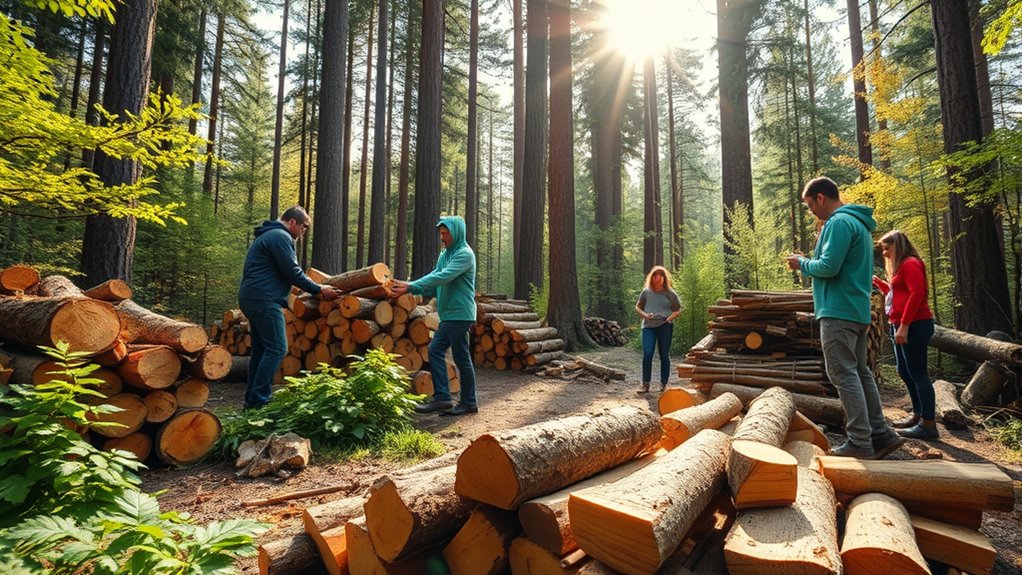
Building community support for sustainable firewood harvesting guarantees that everyone comprehends the importance of protecting wildlife habitats. You can achieve this through effective community outreach, engaging residents, and local groups in conversations about sustainable practices. Organizing educational campaigns helps people understand how responsible harvesting preserves forest health and biodiversity. Share practical tips, such as avoiding overharvesting and selecting dead or fallen wood, to foster stewardship. When community members see the benefits of sustainable methods, they’re more likely to support policies and initiatives that promote conservation. Encourage open dialogue, provide resources, and highlight success stories to motivate collective action. By fostering awareness and support, you ensure that sustainable firewood harvesting becomes a shared goal, benefiting both the forest and the community.
Frequently Asked Questions
How Can I Identify Truly Sustainable Firewood Sources?
You can identify truly sustainable firewood sources by checking for forest certification labels like FSC or PEFC, which guarantee responsible harvesting practices. Additionally, ask about the supplier’s harvest planning, confirming they prioritize low-impact methods and replant trees. Responsible sources will be transparent about their sustainability efforts and follow guidelines that protect forest health. By choosing certified and well-managed sources, you help preserve forests while enjoying your firewood.
What Are the Signs of Overharvesting in a Forest?
Overharvesting is like stripping layers off an onion—you weaken the forest’s core. Signs include reduced forest regeneration, where young trees struggle to grow, and increased wildlife disturbance, as animals lose habitat. You might notice fewer mature trees, trail erosion, or soil compaction. These indicators show the forest’s ability to recover is compromised. Recognizing these signs helps protect the ecosystem and ensures responsible harvesting without harming the forest.
How Do I Ensure My Firewood Collection Doesn’t Spread Pests?
To prevent pests when collecting firewood, you need to focus on pest prevention and proper wood treatment. Always inspect your wood for signs of insects or disease before bringing it home. Use pest-resistant techniques like drying wood thoroughly and avoiding contact with soil. Treat your firewood with approved methods to eliminate pests, and store it away from your home. These steps help protect your property and ensure your firewood remains pest-free.
What Are the Best Ways to Recycle or Reuse Firewood Scraps?
Imagine turning your firewood scraps into useful items. You can recycle firewood scraps by creating scrap wood crafts, like picture frames or coasters, giving them a second life. Firewood composting is another eco-friendly option, where small pieces decompose into nutrient-rich soil. These methods reduce waste and promote sustainability. By repurposing your firewood scraps, you help protect the environment while making practical, handcrafted items that add charm to your home.
How Can Community Efforts Enhance Sustainable Firewood Harvesting?
Community efforts can considerably improve sustainable firewood harvesting by promoting community monitoring, which helps guarantee responsible collection practices. When neighbors share resources and knowledge, you’re better equipped to prevent overharvesting and protect local forests. Working together fosters accountability, educates members on sustainable techniques, and encourages responsible usage. Ultimately, your collective action helps maintain healthy forests while providing enough firewood, balancing community needs with environmental conservation.
Conclusion
By harvesting firewood responsibly, you help preserve forest health for future generations. For instance, a community that follows sustainable practices reduced habitat disruption and maintained biodiversity, proving that careful collection benefits everyone. Always respect local rules, select appropriate wood, and avoid damaging young trees. Your mindful approach guarantees the forest remains vibrant and productive, allowing you to enjoy reliable warmth while safeguarding nature’s delicate balance for years to come.





